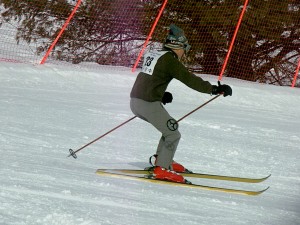
Bogner Logo
Following World War II there were less than 50,000 skiers in the United States. By the end of the 1960’s there were more than 4 million U.S. skiers! There were many factors that influenced that growth: better skis, safer bindings, improved ski lifts, a baby boom, and a thriving economy, for example. But last week’s trivia question asked what technology improvement in the 1950’s was the most significant in fueling the increase in popularity. Granted the answer I was looking for is a matter of opinion, but there are many who share the same opinion.
Paul Mickelson, Holly Rainville, and Bob Burley all provided the correct answer (although it was Bob’s third choice): stretch pants! Well, the actual technology improvement was nylon which was added to the Helanca stretch fabric developed in Switzerland. This gave the fabric more resilience, longer wear, and more water resistance.
The first stretch materials were developed in the early 1930’s and involved weaving wool with a Celanese acetate fiber. However they would lose their stretch relatively quickly, particularly if you washed them.
In the 1950’s nylon replaced the Celanese and new weaving techniques were developed. This led to a fabric with a much stronger stretch that lasted longer even when washed. Now all that was needed was a good fashion designer to apply this new fabric to skiwear.
That designer was Maria Bogner. The Bogner company was already a name in skiwear, but in 1951 Maria began experimenting with the new stretch material trying to produce pants that fit properly. The 1952-53 Bogner catalog included the new stretch pants modeled by such skiing personalities as Stein Eriksen. By 1955 the pants were available in 42 colors and a wide range of sizes. Suddenly skiwear was fashionable and sexy. So skiing was fashionable! Skiing was sexy!
The January 19, 1962 issue of Life magazine features pictures of ski fashions that would normally have only been found in a ski magazine. The issue also includes an article about Don Sauers, author of the Girl Watcher’s Guide, girl watching right here in Stowe! In the article a veteran Stowe Ski Patroller describes the 1- 10 point scoring system used for rating a woman’s stretch pants (a 9 meant you could tell whether a dime in her pocket was heads or tails.)
Seth Masia in an article in Skiing Heritage magazine asserts that stretch pants changed the sexual dynamic of skiing. Prior to stretch pants women took up skiing to meet men, but only after the introduction of stretch pants did men take up skiing to meet women.
Many of us were convinced that we skied better in stretch pants. Skiing is a sport about movement and stretch pants provided support for that movement. Nothing bulky to impede movement, nothing loose to flap in the breeze, they were part of you. Sure they were cold on those subzero days, but what’s a little discomfort when you’re skiing well and looking good.

John Flynn in vintage 70's Bogner's at Antique Ski Race (2011)
Bogners were the ultimate stretch pant. I had friends who would cut off the stirrups so they wouldn’t affect their boot fit and those pants still clung to them all day! One of the racers at the recent Antique Ski Race wore a pair of 70’s vintage Bogner over-the-boot stretch pants. They still looked great! (And apparently they are immune to the shrinkage that my 70’s ski pants have experienced hanging in my closet.)
Those of us who couldn’t afford Bogners usually ended up with “bagners” which tended to be looser at the end of a ski day and usually had two bumps where your knees had been. If you had more than a 15 minute drive to the ski area you learned to bring the pants and put them on at the ski area to delay this effect. There’s a reason why one of Stowe’s famous night spots was called the Baggy Knees!

May 11, 2012 at 2:01 am
Hi there, my dad insists there was a common name beside “stretch pants” for stretch pants. He is driving me crazy trying to find this “extinct” term that was used in the 1960’s. He said that it would be what parka is to jacket and wasn’t a brand name or a fabric name. If anyone would happen to remember what they were called, my dad would greatly appreciate it. He has scoured the internet to no avail. Thank you for any information you may supply.